Ola Svensson
The Cost of Consistency: Submodular Maximization with Constant Recourse
Dec 03, 2024



Abstract:In this work, we study online submodular maximization, and how the requirement of maintaining a stable solution impacts the approximation. In particular, we seek bounds on the best-possible approximation ratio that is attainable when the algorithm is allowed to make at most a constant number of updates per step. We show a tight information-theoretic bound of $\tfrac{2}{3}$ for general monotone submodular functions, and an improved (also tight) bound of $\tfrac{3}{4}$ for coverage functions. Since both these bounds are attained by non poly-time algorithms, we also give a poly-time randomized algorithm that achieves a $0.51$-approximation. Combined with an information-theoretic hardness of $\tfrac{1}{2}$ for deterministic algorithms from prior work, our work thus shows a separation between deterministic and randomized algorithms, both information theoretically and for poly-time algorithms.
Could ChatGPT get an Engineering Degree? Evaluating Higher Education Vulnerability to AI Assistants
Aug 07, 2024
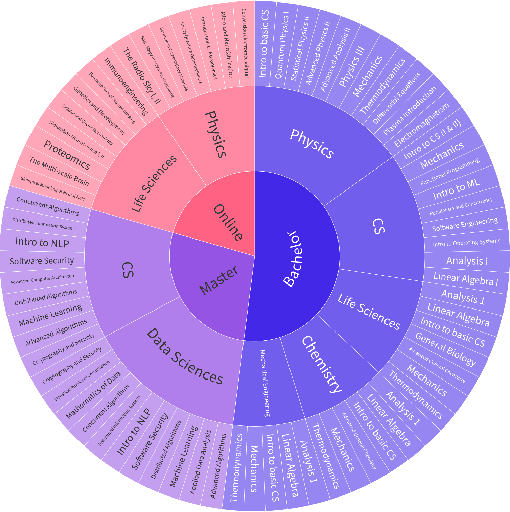
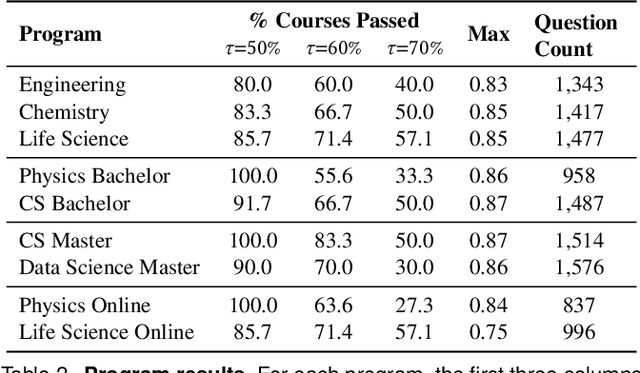

Abstract:AI assistants are being increasingly used by students enrolled in higher education institutions. While these tools provide opportunities for improved teaching and education, they also pose significant challenges for assessment and learning outcomes. We conceptualize these challenges through the lens of vulnerability, the potential for university assessments and learning outcomes to be impacted by student use of generative AI. We investigate the potential scale of this vulnerability by measuring the degree to which AI assistants can complete assessment questions in standard university-level STEM courses. Specifically, we compile a novel dataset of textual assessment questions from 50 courses at EPFL and evaluate whether two AI assistants, GPT-3.5 and GPT-4 can adequately answer these questions. We use eight prompting strategies to produce responses and find that GPT-4 answers an average of 65.8% of questions correctly, and can even produce the correct answer across at least one prompting strategy for 85.1% of questions. When grouping courses in our dataset by degree program, these systems already pass non-project assessments of large numbers of core courses in various degree programs, posing risks to higher education accreditation that will be amplified as these models improve. Our results call for revising program-level assessment design in higher education in light of advances in generative AI.
An Analysis of $D^α$ seeding for $k$-means
Oct 20, 2023Abstract:One of the most popular clustering algorithms is the celebrated $D^\alpha$ seeding algorithm (also know as $k$-means++ when $\alpha=2$) by Arthur and Vassilvitskii (2007), who showed that it guarantees in expectation an $O(2^{2\alpha}\cdot \log k)$-approximate solution to the ($k$,$\alpha$)-means cost (where euclidean distances are raised to the power $\alpha$) for any $\alpha\ge 1$. More recently, Balcan, Dick, and White (2018) observed experimentally that using $D^\alpha$ seeding with $\alpha>2$ can lead to a better solution with respect to the standard $k$-means objective (i.e. the $(k,2)$-means cost). In this paper, we provide a rigorous understanding of this phenomenon. For any $\alpha>2$, we show that $D^\alpha$ seeding guarantees in expectation an approximation factor of $$ O_\alpha \left((g_\alpha)^{2/\alpha}\cdot \left(\frac{\sigma_{\mathrm{max}}}{\sigma_{\mathrm{min}}}\right)^{2-4/\alpha}\cdot (\min\{\ell,\log k\})^{2/\alpha}\right)$$ with respect to the standard $k$-means cost of any underlying clustering; where $g_\alpha$ is a parameter capturing the concentration of the points in each cluster, $\sigma_{\mathrm{max}}$ and $\sigma_{\mathrm{min}}$ are the maximum and minimum standard deviation of the clusters around their means, and $\ell$ is the number of distinct mixing weights in the underlying clustering (after rounding them to the nearest power of $2$). We complement these results by some lower bounds showing that the dependency on $g_\alpha$ and $\sigma_{\mathrm{max}}/\sigma_{\mathrm{min}}$ is tight. Finally, we provide an experimental confirmation of the effects of the aforementioned parameters when using $D^\alpha$ seeding. Further, we corroborate the observation that $\alpha>2$ can indeed improve the $k$-means cost compared to $D^2$ seeding, and that this advantage remains even if we run Lloyd's algorithm after the seeding.
Nearly-Tight and Oblivious Algorithms for Explainable Clustering
Jun 30, 2021

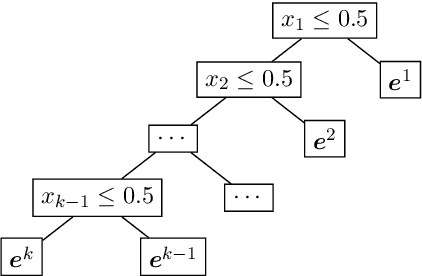
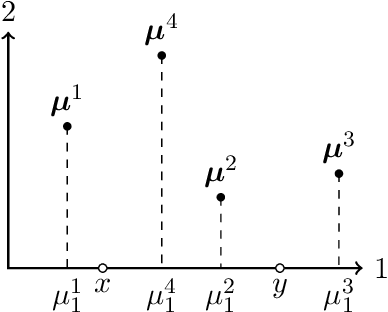
Abstract:We study the problem of explainable clustering in the setting first formalized by Moshkovitz, Dasgupta, Rashtchian, and Frost (ICML 2020). A $k$-clustering is said to be explainable if it is given by a decision tree where each internal node splits data points with a threshold cut in a single dimension (feature), and each of the $k$ leaves corresponds to a cluster. We give an algorithm that outputs an explainable clustering that loses at most a factor of $O(\log^2 k)$ compared to an optimal (not necessarily explainable) clustering for the $k$-medians objective, and a factor of $O(k \log^2 k)$ for the $k$-means objective. This improves over the previous best upper bounds of $O(k)$ and $O(k^2)$, respectively, and nearly matches the previous $\Omega(\log k)$ lower bound for $k$-medians and our new $\Omega(k)$ lower bound for $k$-means. The algorithm is remarkably simple. In particular, given an initial not necessarily explainable clustering in $\mathbb{R}^d$, it is oblivious to the data points and runs in time $O(dk \log^2 k)$, independent of the number of data points $n$. Our upper and lower bounds also generalize to objectives given by higher $\ell_p$-norms.
Fast and Accurate $k$-means++ via Rejection Sampling
Dec 22, 2020



Abstract:$k$-means++ \cite{arthur2007k} is a widely used clustering algorithm that is easy to implement, has nice theoretical guarantees and strong empirical performance. Despite its wide adoption, $k$-means++ sometimes suffers from being slow on large data-sets so a natural question has been to obtain more efficient algorithms with similar guarantees. In this paper, we present a near linear time algorithm for $k$-means++ seeding. Interestingly our algorithm obtains the same theoretical guarantees as $k$-means++ and significantly improves earlier results on fast $k$-means++ seeding. Moreover, we show empirically that our algorithm is significantly faster than $k$-means++ and obtains solutions of equivalent quality.
The Primal-Dual method for Learning Augmented Algorithms
Oct 22, 2020



Abstract:The extension of classical online algorithms when provided with predictions is a new and active research area. In this paper, we extend the primal-dual method for online algorithms in order to incorporate predictions that advise the online algorithm about the next action to take. We use this framework to obtain novel algorithms for a variety of online covering problems. We compare our algorithms to the cost of the true and predicted offline optimal solutions and show that these algorithms outperform any online algorithm when the prediction is accurate while maintaining good guarantees when the prediction is misleading.
Learning Augmented Energy Minimization via Speed Scaling
Oct 22, 2020



Abstract:As power management has become a primary concern in modern data centers, computing resources are being scaled dynamically to minimize energy consumption. We initiate the study of a variant of the classic online speed scaling problem, in which machine learning predictions about the future can be integrated naturally. Inspired by recent work on learning-augmented online algorithms, we propose an algorithm which incorporates predictions in a black-box manner and outperforms any online algorithm if the accuracy is high, yet maintains provable guarantees if the prediction is very inaccurate. We provide both theoretical and experimental evidence to support our claims.
Beyond $1/2$-Approximation for Submodular Maximization on Massive Data Streams
Aug 06, 2018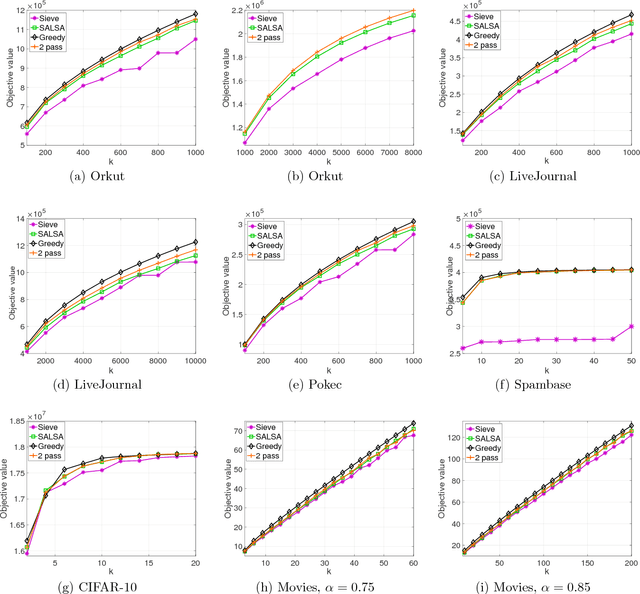
Abstract:Many tasks in machine learning and data mining, such as data diversification, non-parametric learning, kernel machines, clustering etc., require extracting a small but representative summary from a massive dataset. Often, such problems can be posed as maximizing a submodular set function subject to a cardinality constraint. We consider this question in the streaming setting, where elements arrive over time at a fast pace and thus we need to design an efficient, low-memory algorithm. One such method, proposed by Badanidiyuru et al. (2014), always finds a $0.5$-approximate solution. Can this approximation factor be improved? We answer this question affirmatively by designing a new algorithm SALSA for streaming submodular maximization. It is the first low-memory, single-pass algorithm that improves the factor $0.5$, under the natural assumption that elements arrive in a random order. We also show that this assumption is necessary, i.e., that there is no such algorithm with better than $0.5$-approximation when elements arrive in arbitrary order. Our experiments demonstrate that SALSA significantly outperforms the state of the art in applications related to exemplar-based clustering, social graph analysis, and recommender systems.
 Add to Chrome
Add to Chrome Add to Firefox
Add to Firefox Add to Edge
Add to Edge